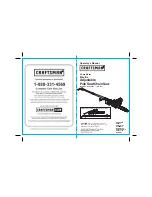
27
26
OPERATION FOR POLE SAW cont.
2. Use both hands to grip Pole Saw. Use only designated grip areas when operating Pole Saw
(See Fig. 19). Use firm grip. Thumbs and fingers must wrap around Pole Saw handle and pole.
3. Make sure your footing is firm. Keep feet apart. Divide your weight evenly on both feet.
4. When ready to make a cut, press the Lock-off Button, then fully press the On/off Switch
(See Fig. 20). This will turn Pole Saw on. Releasing On/off Switch will turn Pole Saw off.
Make sure saw is running at full speed before starting a cut.
5. When starting a cut, place moving chain against wood. Hold Pole Saw firmly in place to avoid
possible bouncing or skating (sideways movement) of saw.
6. Guide Pole Saw using light pressure. Do not force Pole Saw. The motor will overload and can
burn out. It will do the job better and safer at the rate for which it was intended.
7. Remove Pole Saw from a cut with saw running at full speed. Stop Pole Saw by releasing
trigger. Make sure chain has stopped before setting Pole Saw down.
SAW MAINTENANCE
Follow maintenance instructions in this manual. Proper cleaning of saw and chain and Guide
Bar maintenance can reduce chances of kickback. Inspect and maintain saw after each use.
This will increase the service life of your saw.
Note: Even with proper sharpening, risk of kickback can increase with each sharpening.
MAINTENANCE AND STORAGE OF CHAIN SAW
If the replacement of the supply cord is necessary, this has to be done by the manufacturer
or his agent in order to avoid a safety hazard.
1. Unplug chain saw from power source
• When not in use • Before moving from one place to another
• Before servicing • Before changing accessories or attachments, such as saw chain and guard
2. Inspect chain saw before and after each use. Check saw closely if guard or other part has
been damaged. Check for any damage that may affect operator safety or operation of saw.
Check for alignment or binding of moving parts. Check for broken or damaged parts.
Do not use chain saw if damage affects safety or operation. Have damage repaired by
authorized service center.
Fig. 19
Fig. 20
1
2
TRIMMING A TREE (PRUNING)
WARNING:
Avoid kickback. Kickback can result in severe injury or death.
See Kickback, to avoid risk of kickback.
!
WARNING:
Do not extend arms above shoulders when using Pole Saw.
!
CAUTION:
Seek professional help if facing conditions beyond your ability.
!
WARNING:
Do not operate Pole Saw while: • in a tree • on a ladder or any
other unstable surface • in any awkward position
YOU MAY LOSE CONTROL OF POLE SAW CAUSING SEVERE INJURY.
!
Trimming a tree is the process of cutting limbs from a living tree. Make sure your footing is firm.
Keep feet apart. Divide your weight evenly on both feet.
Follow directions below to trim a tree.
1. Make first cut six inches from tree trunk on underside of limb. Use top of guide bar to
make this cut. Cut 1/3 through diameter of limb (See Fig. 21).
2. Move two to four inches farther out on limb.
Make second cut from above limb.
Continue cut until you cut limb off.
3. Make third cut as close to tree trunk as possible
on underside of limb stub.
Use top of guide bar to make this cut.
Cut 1/3 through diameter of stub.
4. Make fourth cut directly above third cut.
Cut down to meet third cut.
This will remove limb stub.
OPERATION FOR POLE SAW
Cutting with extension pole
1. Connect saw to extension cord. Connect extension cord to power supply.
Before cutting a high branch, consider all the same points detailed in the previous section
but pay particular attention to the likely path of the falling branch.
WARNING:
Do not stand directly below a branch being cut. Keep bystanders
far away. Do not stand on a ladder or other type of unstable support while using
the tool. Do not use the tool near cable, electrical power or telephone lines.
Keep 10 ft (3m) away from all power lines. (See Figs. 18a, b, c, and d)
!
Fig. 18a
Fig. 18c
Fig. 18b
Fig. 18d
2" to 4"
(5 a 10 cm)
6"
(15 cm)
W
Y
Z
X
Y
1/3
Fig. 21



































